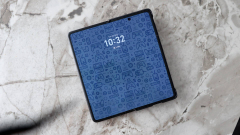Last year Honor’s Magic V3 foldable phone impressed, offering mature software, a thin and robust design and more powerful hardware. This year, thanks to the unlucky reputation of the number four in China, we’ve gone up two to the Magic V5.
The new phone follows industry trends in offering a slimmer design, a bigger battery, improved cameras, a larger internal screen and more powerful internals – including Snapdragon’s 8 Elite processor, 16GB of RAM and 512GB of storage.
But do these upgrades offer a meaningful upgrade over the 2024 model, given that the price has climbed to a massive £1699, a big ask even for this ultra-premium category? Or are you better off sticking with something a few generations older at something like half the price?
Design
The Magic V5 is a tad more reserved in its colour selection than its reddish brown or green predecessors. Instead, it’s black, ivory white and the stylish dawn gold – the pick I’d personally go with. Our sample came in black.
Putting it against my Magic V3, the new model’s camera bump protrudes a bit more due to some internal upgrades I’ll discuss later. However, the overall profile of the phone, both unfolded and folded, is even slimmer than its predecessor.
Interestingly, it’s the ivory white version that’s technically the slimmest, at just 4.1mm unfolded and 8.8mm when folded; the black and dawn gold models sit at 4.2mm and 9mm respectively. Nonetheless, that’s still 0.2-0.3mm less than the Magic V3, and virtually identical to the new Samsung Galaxy Z Fold 7’s 8.9mm total thickness. The Google Pixel 10 Pro Fold, at 10.8mm, is a positive porker by comparison.

As much as the thickness and weight (of 217g) aren’t massive departures from the V3, it feels good to know that we’ve gotten to the stage where foldable phones aren’t cumbersome to use. The Magic V5 fits into a regular-sized pocket and into adult hands without issues, whether folded or unfolded. As with its predecessor, you’ll have to keep a good grip on it when using it in tablet mode one-handed. Weirdly, this new model doesn’t have the same textured finish on the rear as the Magic V3 did, making it a bit more slippery.
The Magic V5 also runs with the typical modern design that Honor has typified these Magic foldables with, with a slender feel and super-thin bezels around the cover screen and main display to maximise screen real estate. I still think there’s some potential for dust and dirt ingress around the main screen, though I didn’t spot anything too egregious on my review unit.

There is a similar Honor “super steel” hinge involved with this phone, which has seen some upgrades to withstand even more pressure. Honor advertising includes some big claims, including the ability to suspend 30kg of stuff from the hinge – though they obviously don’t recommend it for normal use – and the durability rating sits at 500,000 cycles.
One of the biggest upgrades with the Magic V5 is to its water and dust resistance rating, as the phone now has full-fat IP58/IP59 dust and water resistance. Its predecessor was only IPX8. By comparison, the ZFold 7 has an IP48 water resistance rating, and the Pixel 10 Pro Fold is the first IP68-rated foldable.
Display
Honor has maximised screen real estate and brightness with the Magic V5 in a move that sees the main display get a slight boost to 7.95 inches in size, while the cover display remains at 6.43 inches. Both panels can get up to 5000 nits of peak brightness with HDR in supported content for an eyeball-searing experience; these screens aren’t half short of punch, and are both OLEDs for immense depth and lovely colours.
Owing to it being slightly larger, the main display has also seen a push up to 2352×2172 resolution – about the same number of pixels as a 2560×1440 (“1440p”) display – which makes it a fantastic choice for everything from general productivity to gaming and binging content on Plex, YouTube or Prime Video. The pixel density is virtually unchanged at 403ppi, while a 120Hz refresh rate keeps things responsive.

The smaller cover display impresses too, with the same 2376×1060 resolution as its predecessor, plus a 120Hz refresh rate for added zippiness. When opening the main display feels a little cumbersome, or you just want to quickly check notifications, this is a more than suitable deputy. Both screens support stylus input, though you will need to buy Honor’s stylus separately and there’s no place to store the stylus in the phone.
Certain apps and content will have a letterbox effect, not filling the screen entirely, but you can force apps and games on an individual basis to fill the screen so you can take advantage of the full 7.95 inches of real estate.
Camera
Perhaps the biggest upgrade with the Magic V5 is with what Honor has termed its new ‘AI Falcon’ camera setup, which they say gives a conventional flagship experience in a foldable form factor. It’s typically with their camera setup that foldables have made some compromises, but Honor has attempted to change that.
We’ve got a 50MP main camera, plus a boosted 64MP periscope-lens telephoto with 3x optical zoom and 100x digital zoom, and a 50MP ultrawide sensor.
General detail and colours are pleasant across the board in my testing on a few walkabouts in London, although I still think the Magic foldable cameras tend to favour over-saturated colours for as much pop as possible; the shot of the back of the Routemaster bus proves this.
1 of 21
Caption
Attribution
Cropping into shots reveals a strong maintenance of detail from the main and ultrawide sensors, while the 3x optical zoom provides some good quality when punching in on a subject a tad. Going into the digital zoom range requires some AI he





